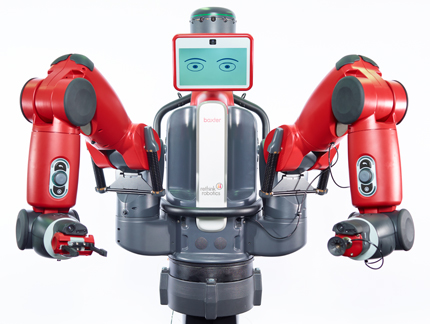Training Systems Australia is proud to announce that five Australian universities have now installed a
Baxter Research Robot in order to carry out various research projects in a variety of fields.
The universities, University of Melbourne, Deakin University, Edith Cowan University, University of Sydney and Flinders University are all now exploring ways in which Baxter can be used in collaboration with humans to carry out multiple tasks. A number of other Australian, New Zealand and S.E Asian universities are currently seeking funding for the purchase of a Baxter Research Robot.
These universities are joining many other universities around the world who are using the Baxter Research Robot to conduct investigations in many areas of endeavour.
These include:
Autonomous Systems
Researchers at Carnegie Mellon University successfully used the Baxter Research Robot in conjunction with their mobile delivery robot, CoBot, to collaborate autonomously for order fulfilment. In this example, CoBot and Baxter communicate directly via ROS bridge, to update each other dynamically while executing the task. This communication takes two forms; delivery fulfilment and positioning. In delivery fulfilment, CoBot requests a specific, QR-coded part from Baxter, and Baxter utilizes its embedded camera system to locate and then pick the requested object. Next, Baxter queries CoBot for its position, and if Baxter is unable to reach, requests CoBot to move to a new location. Finally, Baxter delivers the part to CoBot, and asks CoBot to go deliver the part.
Click here to visit the Website.
Human-Assistive Robotics
Researchers at the University of Wyoming are using the embedded cameras and safety compliance of the Baxter Research Robot to develop new programs aimed at improving human rehabilitation through visual and physical assistance of remote patients.
Click here to visit the Website.
Researchers at Carnegie Mellon University are using the Baxter Research Robot to explore novel ways in which assistive robots can empower individuals with disabilities, particularly in overcoming the challenges of navigating unfamiliar environments and achieving independent transportation.
Click here to visit the Website.
Researchers at the Rensselaer Polytechnic Institute utilize a customized controller designed for handicapped persons, and a MATLAB® implementation interface, to drive the movements of the Baxter Research Robot. This work may contribute to more capable home assistance robots for individuals with physical disabilities.
Click here to watch the Video.
Researchers at the University of Pennsylvania Perelman School of Medicine are planning to use the Baxter Research Robot, coupled with novel end-of-arm tooling and human interaction algorithms, to help provide rehabilitation services to patients suffering from dysfunctions arising from aging and/or neural injury.
Click here to visit the Website.
Machine Learning & Artificial Intelligence
Researchers at the Cornell Robot Learning Lab are using the Baxter Research Robot to develop new algorithms to enable robots to more effectively and efficiently gather information about their environment, to help them become better operators of human tasks in the real world.
Click here to watch the Video.
Computer/Machine Vision
Researchers at Cornell University use a Kinect-style camera mounted to the frame of the Baxter Research Robot to enable autonomous real-time decision-making and task execution in response to changes in the environment. In this example, Baxter “learns” dynamically to pick up previously unseen objects by utilizing novel vision algorithms to process and deconvolute complex 3-D images in real-time. Results of this work were recently published:
Deep Learning for Detecting Robotic Grasps, Ian Lenz, Honglak Lee, AshutoshSaxena. In
Robotics: Science and Systems (RSS), 2013.
Click here to visit the Website.
Researchers at the Missouri University of Science & Technology use a Kinect-style camera and the open source Point Cloud Library to enable the Baxter Research Robot to localize objects in a randomized field under conditions considered challenging for traditional 2-D vision systems.
Click here to watch the Video.
Researchers at MIT use the Baxter Research Robot’s inherent grasping and path trajectory capabilities together with a Kinect-style camera to reproducibly generate 3-D models of people and objects, with a goal of compiling a comprehensive library of environmental models for use in marine environments.
Click here to watch the Video.
Mechatronics & Grasp Research
Researchers at Worcester Polytechnic Institute are using Baxter as a humanoid test platform for novel gripper development, with goals of improving robotic grasping in both industrial and prosthetic applications.
Click here to watch the Video.
Education & Outreach
Researchers at Tufts University use Baxter as part of their Engineering and Education Outreach program, which is focused on increasing engineering education integration in grades K-12. To promote this goal, the group has developed a series of novel user interfaces for the Baxter Research Robot, including one based on LabView, to allow children to more readily and easily explore topics ranging from applied physics to mechatronics to computer programming. See also the recent webinar featuring their work:
Click here to watch the Video.
Researchers at Northwestern University are using the Baxter Research Robot as one of the test beds for their Master of Science in Robotics graduate program. Students will make use of the platform in courses and projects focused on a variety of topics, including motion planning, haptics, and human-robot interaction.
Click here to visit the Website.
For more information on the Baxter Research Robot please contact our office on +61 03 9557 7993.
